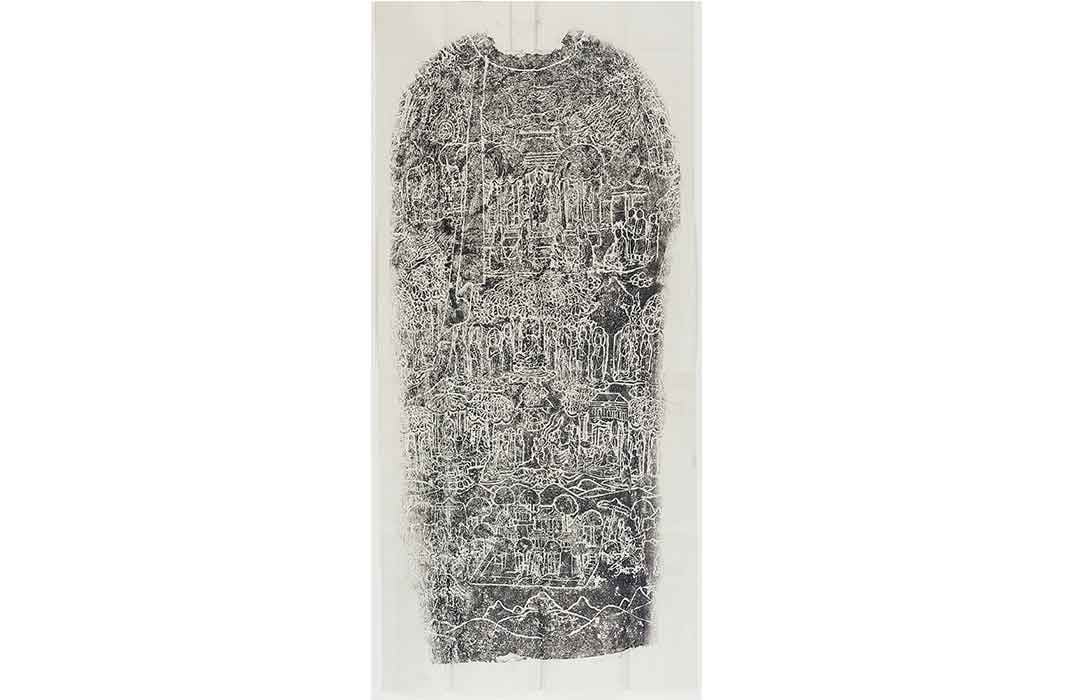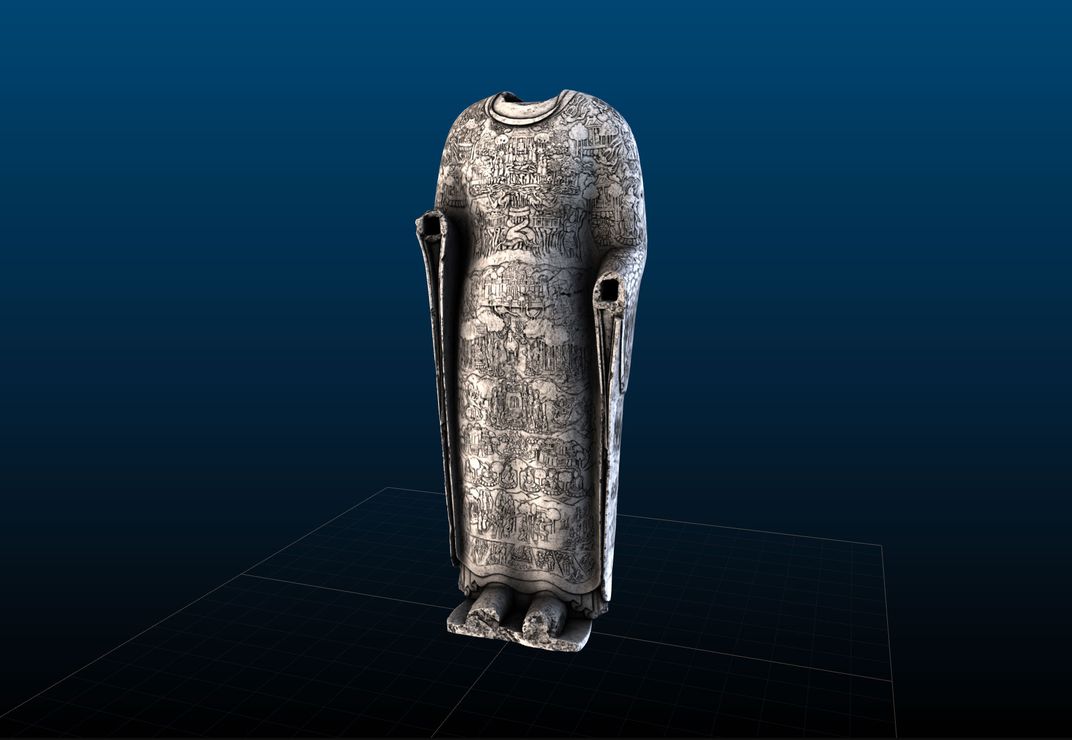Curators Discover New Details in the Etchings on a 6th-Century Chinese Sculpture
A headless figure, cloaked in a robe covered with complex illustrations, is now better understood thanks to 3D technology
:focal(536x81:537x82)/https://tf-cmsv2-smithsonianmag-media.s3.amazonaws.com/filer/9b/e5/9be5e62b-b3de-4e43-b5ca-e55d04181464/fs808604web.jpg)
A life-size limestone sculpture created in the late sixth century, and bearing intricately involved narrative details carved into its robe, was likely used as a teaching tool to instruct students about Buddha’s life and teachings. The digital tools used to make an unprecedented three-dimensional scan of the Buddha, part of the collections of the Freer and Sackler Galleries, couldn’t be more different from the sculptor’s techniques employed 15 centuries ago. But their educational motivations are surprisingly similar.
Over the centuries significant pieces of the Chinese sculpture, known as Buddha draped in robes portraying the Realms of Existence, or Cosmic Buddha, were lost including the head, hands, parts of its feet and portions of its base.
But standing in front of this masterpiece of Buddhist art, a few days before the opening of the exhibition “Body of Devotion: The Cosmic Buddha in 3D,” J. Keith Wilson, curator of ancient Chinese art at the Freer and Sackler Galleries, reflected on how rare and unusual the work was. The exhibition includes the ancient sculpture along with touchscreen monitors that allow visitors to drill down into super magnified images to study the complex illustrations that cover the sculpture.
Until 1996 when a number of others sculptures like the Cosmic Buddha were discovered, the work—dating to the northern Qi dynasty (550-577)—was “truly unique—like capital ‘U’ unique,” says Wilson.
“It was the only example that was known of this scale and of this complexity of decoration from the late sixth century,” he says. Depictions of sacred texts decorate virtually every available square inch of the Buddha’s robes. The images are a symbolic map of the Buddhist world and include scenes of hell and paradise.
In 1996, when the cache of about 200 similar Buddha sculptures was discovered in Qingzhou, China—about 150 miles from the site where this sculpture was made, two more had significant and similar narrative decoration, but the details were much “sketchier,” says Wilson. The 1996 discoveries had been buried in sand, so they retained some of their original gold, blue, red and green pigmentation. The Buddha sculpture, says Wilson, was likely painted similarly.
Cosmic Buddha, he says, “now has a little bit of a peer group, and also the issue of pigment has helped us understand why the surface is so complex and how it might have been easier to read in the sixth century than it is today.”
Given the sculpture’s dramatic narrative detail, Wilson thinks it was likely installed in a temple courtyard and used—almost like a sacred textbook—by abbots to instruct students. The robe is decorated around its entire circumference because the abbot would have walked around it, drawing upon its various depictions of the Buddhist cosmos as he taught student believers. The latter, Wilson adds, would not have necessarily been young.
“With something as rich and potent as the Cosmic Buddha, teaching could have occurred at different levels for different audiences,” he says.
With the help of the Smithsonian’s Digitization Program Office, Wilson has been able to append his scholarly observations and explication to the digital model. The digital tools approximate the sort of pictorial-to-text interpretation that the sixth-century abbots would have shared with their students.
“Being able to encode information directly on the surface of the piece is something that was impossible before scanning,” Wilson says.

Of course the sculpture, which the Freer acquired in 1923, is made of stone rather than digital data points. But for a few dark blotches—which might have come from ink rubbings and were removed—the sculpture is in very good shape, except for small areas where unknown organic substances discolor the stone.
“Otherwise, I think you’re looking at a fairly pristine sixth century surface,” Wilson notes.
Thankfully, there was little 20th century re-carving of the narrative designs, although Wilson points out an area where a face was clearly redrawn in a modern manner. “It looks so cartoonish,” he adds.
And then there are the lost parts of the sculpture, which was formed from a single limestone block. As is typical for Buddha sculptures, Wilson says that the head would have had short, cropped hair, with little curls. The right hand would’ve been raised in a teaching gesture approximating an ‘A-OK’ symbol, and the left hand would have been lowered, suggesting benevolence.
Wilson notes the damage may have occurred during an anti-Buddhist campaign—the worst of which occurred in the mid-ninth century—and although replacement parts were added, those too had disappeared by 1923.
The original base, Wilson says, would likely have contained a lotus design. It rests now on a concrete block. “I think this solution is actually quite elegant,” he says. “Some people might think it’s a little bit harsh, a little strong, a little kind of Army Corps of Engineers response to the issue, but in a way I like it. It’s abstract. We’ve never shown it before with the concrete exposed.”
In the sixth century, the court strongly supported Buddhism, which came to touch all levels of society, says Wilson. At the time, imperial coffers funded a “staggering” number of monks and temples, he adds. “The guidance for the decoration may well have come from the chief abbots of the dynasty.”
Where Smithsonian staffers have used digital tools to map out the three-dimensional object, transferring the information onto devices that display on two-dimensional screens, the work was originally created in the reverse order. The designer would have mapped the scenes out in ink on paper, and then pressed the paper to stone—almost like a stencil—before carving the surface.
“It’s a sculpture, yes, but it’s also kind of a series of paintings captured in stone,” Wilson says.

Unlike prior ink rubbings, which carry high contrasts, the 3D scans are essentially a series of measurements, which Wilson has been able to manipulate for closer study. By playing with the contrast, he has been able to see figures more clearly than he believes anyone has before. “The detail on the surface is absolutely mind-boggling,” he says.
The 3D digitization of the sculpture was ripe with scholarly promise. Incremental findings culminated in a “big aha moment,” says Wilson. Some sections that scholars had previously thought of as separate stories, Wilson came to realize were actually a single story from the same sutra, or part of Buddhist scripture, while other sections that had been regarded as connected proved to be far less related once he was able to look at the finer details more closely.
“That aha moment for me was realizing that the narrative structure here is really complicated and probably reflects the finest level of two-dimensional artistic production of the sixth century,” he says.
The front of the sculpture, which Wilson calls the Buddha’s “key content,” maps out the realms of the Buddhist universe, which include heaven, earth (home to both people and animals), the spirit world and hell. The depiction of hell in the sculpture is “pretty graphic,” Wilson points out. Buffalo-headed jailors carry pokers; people are burnt and made to lie on stone beds above flames; and other damned are forced to climb razor trees.
“They’re clearly made to scare the sh-t out of you,” Wilson says.
A different sort of complexity emerges atop the front of the sculpture, where heaven is represented. The artist portrayed deities flying into heaven on lotuses in anticipation of a sermon that Buddha will deliver atop the spiritual mountain of Meru—the Buddhist equivalent perhaps of Olympus. The layer of heaven portrayed is called Trayastrimsha, which is the “highest of the Buddhist heavens that can still be seen or imagined by believers,” says Wilson. “It is supported by two dragons, which are wrapped around Mount Meru in the conceptual depiction of the heavens on the sculpture.”
“There’s this great sense of movement going on,” Wilson says. “What could be a very static, symmetrical kind of airless depiction of an iconic moment has become something that is full of life and motion.”
“Body of Devotion: The Cosmic Buddha in 3D” is on view at the Arthur M. Sackler Gallery in Washington, D.C. through December 2016.
/https://tf-cmsv2-smithsonianmag-media.s3.amazonaws.com/accounts/headshot/mw_by_vicki.jpg)
/https://tf-cmsv2-smithsonianmag-media.s3.amazonaws.com/accounts/headshot/mw_by_vicki.jpg)